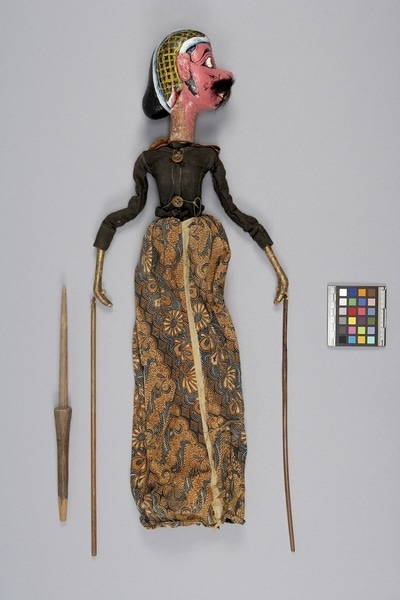Rod Puppet Item Number: Ib318 from the MOA: University of British Columbia


Description
A three-dimensional male humanoid figure puppet. Has a large head and jointed arms attached to controlling rods. The pink face is positioned upwards with white eyes that have red irises. There are prominent white upper teeth with red lips. Facial hair and details are painted in black. Hair (human ?) is attached to the face to form a moustache. The head is covered in a hairnet in the Javanese style in black, yellow, blue, white, and red. The upper torso is covered in a tight fitting brown garment with two plastic buttons and two tacked epaulettes: one cloth and one plastic. The arms are very long with the upper arms of twisted cloth which appear very flexible and unrealistic. Wearing a long batik skirt in brown, blue, and beige.
History Of Use
Javanese puppetry as an art form probably developed by the 11th century. Wayang golek puppets of western Java appeared during the 16th century. Originally the plays depicted Javanese mythology, but after the Indian conquest of Java the Hindu epics, Ramayana and Mahabharata, were incorporated into the cycles, which comprise about 200 plays. A dalang (puppet master) performs the plays to celebrate important occasions, usually in three acts, with vocal and instrumental accompaniment. Typically they serve a moral and religious purpose, and more recently, one of political commentary. Citrayuda is a raden (prince) of the Mahabharata cycle, which is largely concerned with the legendary conflict between the Kurawa and Pandawa brothers. He is known as a particularly aggressive ally of the evil Kurawas, who are defeated by the noble Pandawas after usurping their kingdom.
Cultural Context
Theatrical performance.
Iconographic Meaning
Each puppet is characterized by it's wanda, a Javanese word which describes the specific mixture of elements of size, form, colour, ornamentation and carving. Position and colour of eyes and face indicate aggressiveness and irreverence. Exaggerated features suggest lack of refinement. Batik skirt worn by characters of rank only, as are tight-fitting garments. Significance of human hair not known. Hairnet, facial features, and clothing indicate the character is an advisor or less traditional warrior. Puppet tentatively identified as Citrayuda, although facial hair and epaulettes are clearly variant.
Item History
- Made in Java, Indonesia
- Owned by Tradewind Antiques before March 15, 1983
- Received from Museum of Anthropology Shop Volunteers (Funding source) and Tradewind Antiques (Seller) on March 15, 1983
What
Who
- Culture
- Sundanese
- Previous Owner
- Tradewind Antiques
- Received from
- Museum of Anthropology Shop Volunteers (Funding source) and Tradewind Antiques (Seller)
Where
- Holding Institution
- MOA: University of British Columbia
- Made in
- Java, Indonesia
When
- Ownership Date
- before March 15, 1983
- Acquisition Date
- on March 15, 1983
Other
- Condition
- fair
- Accession Number
- 0886/0052